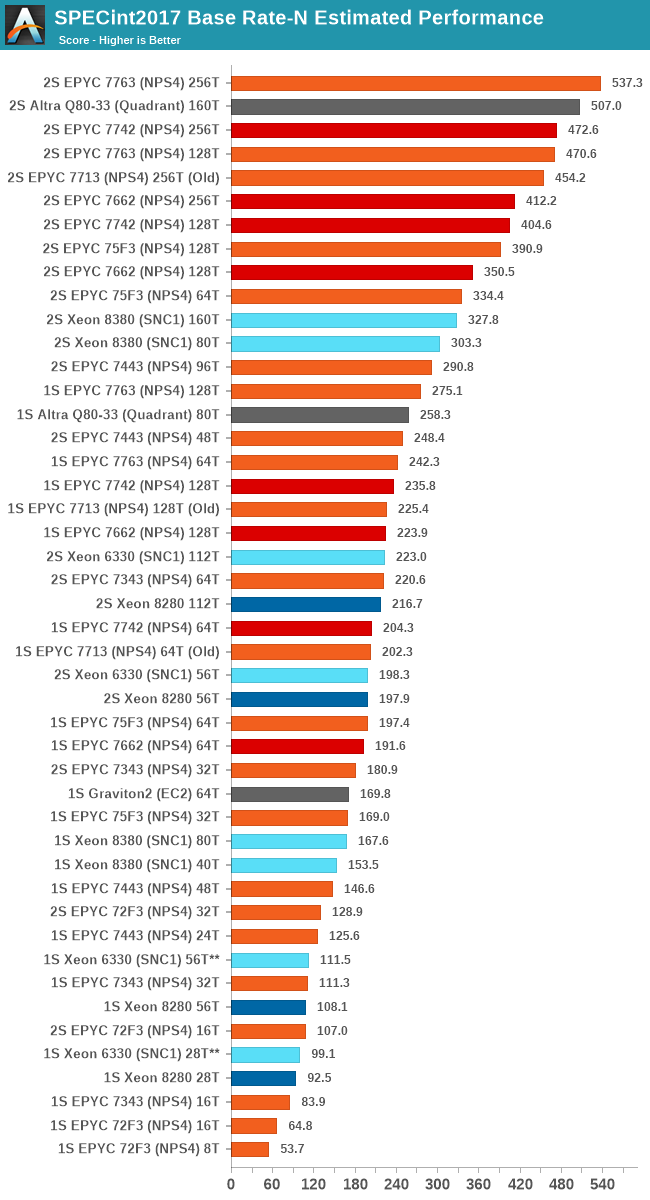AMD EPYC Milan Review Part 2: Testing 8 to 64 Cores in a Production Platform
by Andrei Frumusanu on June 25, 2021 9:30 AM ESTSPEC - Multi-Threaded Performance - Aggregate
Due to the number of SKUs, I’m splitting up the aggregate scores on its own page:

In SPECint2017, for the high-end SKUs, we see the 7763 improve its 2S score by 4.89%, while the 1S score increases by 7.9%. The 75F3 also similarly sees a +3.9% 2S increase, and a 5.4% 1S increase, both extending their leadership positions.
The low-core count SKUs, while notably quite lower in their relative performance, are still extremely impressive from a competitive landscape, with again the 16-core 7343 having no issues in keeping up with the new 28-core Xeon 6330 or last-gen flagship Xeon 8280.

In the floating-point suite more representative of HPC workloads, we again also see the 7763 increase its scores by +1.3% in 2S and +4.2% in 1S configurations, while the 75F3 increases its positioning by +4.2% and +4.8%. The increases don’t change the overall landscape much, but it allows the parts to be better than initially reviewed.
Again, the 7443 and 7343 are excellent performers here given they outperform the Xeon 6330 and Xeon 8280.










58 Comments
View All Comments
Threska - Sunday, June 27, 2021 - link
Seems the only thing blunted is the economics of throwing more hardware at the problem. Actual technical development has taken off because all the chip-makers have multiple customers across many domains. That's why Anandtech and others are able to have articles like they have.tygrus - Sunday, June 27, 2021 - link
Reminds me of the inn keeper from Les Miserables. Nice to your face with lots of good promises but then tries to squeeze more money out of the customer at every turn.tygrus - Sunday, June 27, 2021 - link
I was ofcourse referring to the SW not the CPU.130rne - Tuesday, September 14, 2021 - link
What the hell did I just read? Just came across this, I had no idea the enterprise side was this fucked. They are scalping the ungodly dog shit out of their own customers. So you obviously can't duplicate their software in house meaning you're forced to use their software to be competitive, that seems to be the gist. So I buy a stronger cpu, usually a newer model, yeah? And it's more power efficient, and I restrict the software to a certain number of threads on those cpus, they'll just switch the pricing model because I have a better processor. This would incentivize me to buy cheaper processors with less threads, yeah? Buy only what I need.130rne - Tuesday, September 14, 2021 - link
Continued- basically gimping my own business, do I have that right? Yes? Ok cool, just making sure.eachus - Thursday, July 15, 2021 - link
There is a compelling use case that builders of military systems will be aware of. If you have an in-memory database and need real-time performance, this is your chip. Real-time doesn't mean really fast, it means that the performance of any command will finish within a specified time. So copy the database on initialization into the L3 cache, and assuming the process is handing the data to another computer for further processing, the data will stay in the cache. (Writes, of course, will go to main memory as well, but that's fine. You shouldn't be doing many writes, and again the time will be predictable--just longer.)I've been retired for over a decade now, so I don't have any knowledge of systems currently being developed.
Who would use a system like this? A good example would be a radar recognition and countermeasures database. The fighter (or other aircraft) needs that data within milliseconds, microseconds is better.
hobbified - Thursday, August 19, 2021 - link
At the time I was involved in that (~2010) it was per-core, with multiple cores on a package counting as "half a CPU" — that is, 1 core = 1CPU license, two 1-core packages = 2CPU license, one 2-core package = 1CPU license, 4 cores total = 2CPU license, etc.I'm told they do things in a completely different (but no less money-hungry) way these days.
lemurbutton - Friday, June 25, 2021 - link
Can we get some metrics on $/performance as well as power/performance? I think the Altra part would be better value there.schujj07 - Friday, June 25, 2021 - link
"Database workloads are admittedly still AMD’s weakness here, but in every other scenario, it’s clear which is the better value proposition." I find this conclusion a bit odd. In MultiJVM max-jOPS the 2S 24c 7443 has ~70% the performance of the 2S 40c 8380 (SNC1 best result) despite having 60% the cores of the 8380. In the critical-jOPS the 7443's performance is between the 8380's SNC1 & SNC2 results despite the core disadvantage. To me that means that the DB performance of the Epyc isn't a weakness.I have personally run the SAP HANA PRD performance test on Epyc 7302's & 7401's. Both CPUs passed the SAP HANA PRD performance test requirements on ESXi 6.7 U3. However, I do not have scores from Intel based hosts for comparison of scores.
schujj07 - Friday, June 25, 2021 - link
The DB conclusion also contradicts what I have read on other sites. https://www.servethehome.com/amd-epyc-7763-review-... Look at the MariaDB numbers for explanation of what is being analyzed. Their 32c Epyc &543p vs Xeon 6314U is also a nice core count vs core count comparison. https://www.servethehome.com/intel-xeon-gold-6314u... In that the Epyc is ~20%+ faster in Maria than the Xeon.